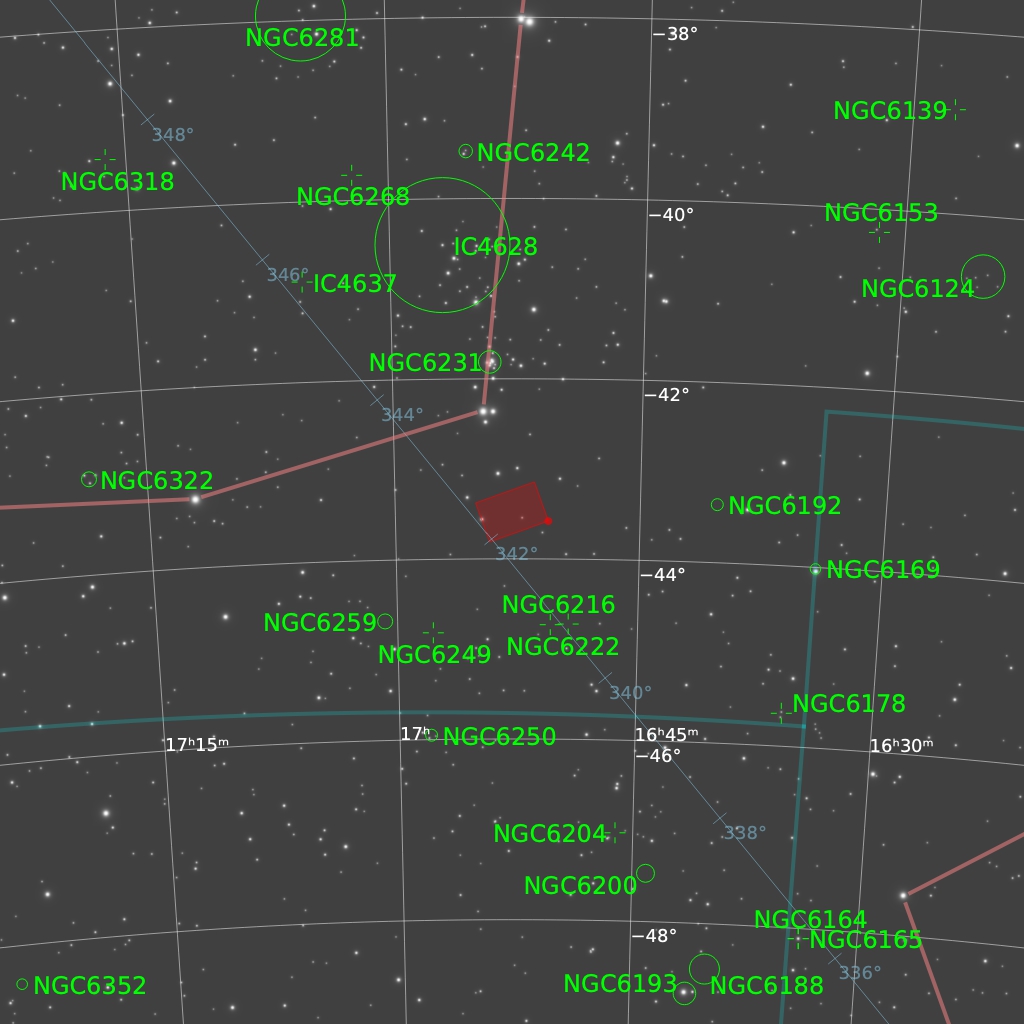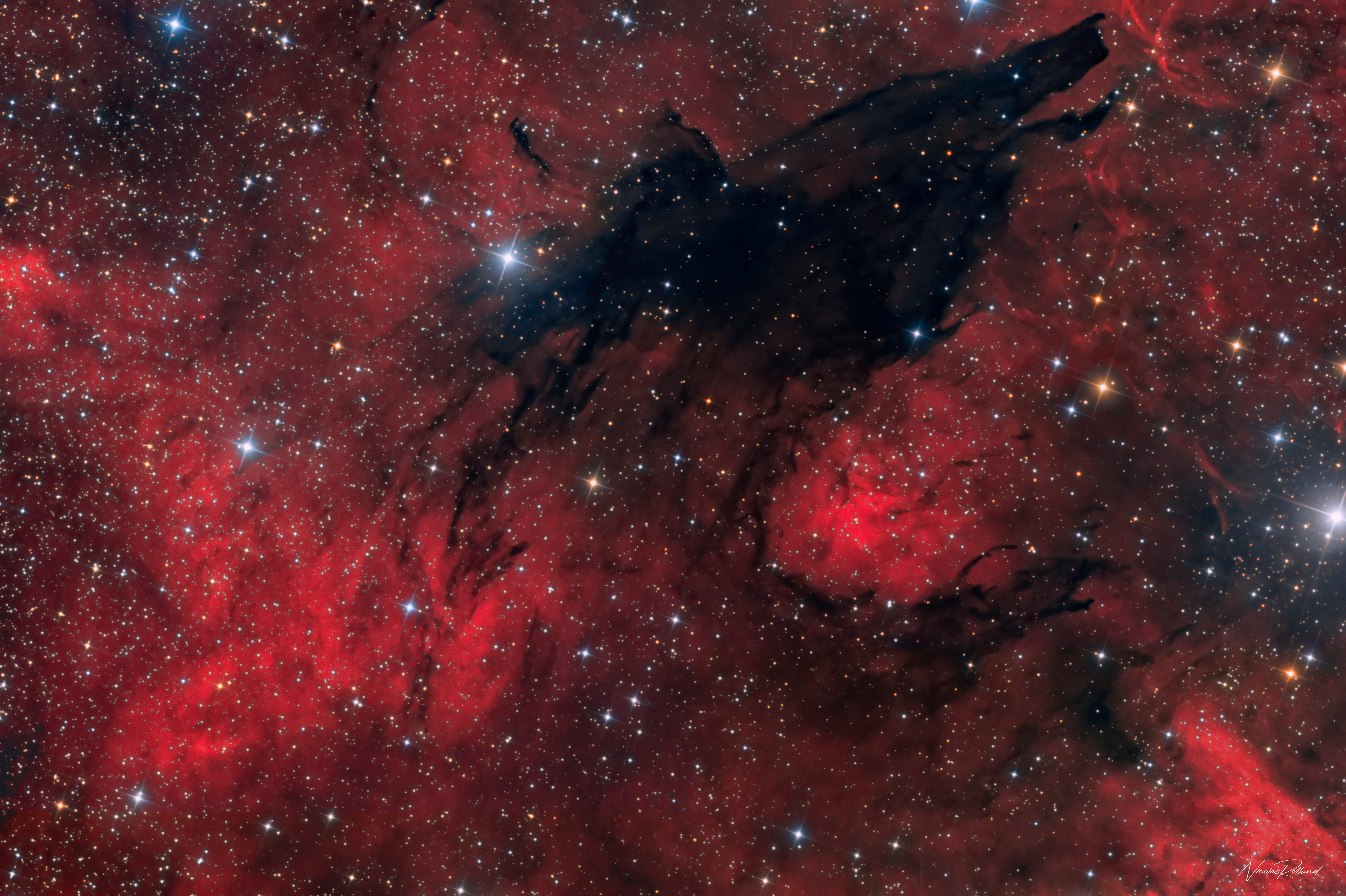The Dark Wolf Nebula
SL 17
Nestled in the constellation Scorpius lies SL17, also known by the name of the Dark Wolf Nebula. Picture this mysterious silhouette cutting across the sky like a cosmic wolf against a backdrop of scarlet red nebulae—a breathtaking spectacle in the southern sky.
A Shadow Against the Stars
Located about 5,300 light-years from home, this nebula spans 7 light-years across. Unlike its blazing neighbors, it doesn't shine—instead, it plays the role of a cosmic curtain, blocking the light from stars trying to pierce through it.
Here's where things get fascinating: where matter accumulates most densely, it absorbs almost all the incoming light, creating these striking contours that evoke a wolf in motion. Behind this dark veil, the nebulae of the Scorpius-Centaurus association—one of the busiest neighborhoods in our galaxy for star birth—glow red in hydrogen-alpha light, bathed in ultraviolet rays from still-young stars.
A Stellar Nursery in Disguise
Beneath its appearance, the Dark Wolf Nebula hides a cradle of creation. Deep within its cold interior—where temperatures drop to just 10-20 Kelvin—gravity slowly gathers clumps of gas and dust. Over time, these fragments collapse to form new stars.
This dust is so dense it exceeds what we typically find in space by several hundred times. That's exactly what it takes for stars to be born! And those magnificent red veils surrounding it? They're living witnesses to this process: they shine thanks to massive stars that were themselves born in similar dark cradles just a few million years ago.
A Window into Stellar Evolution
SL17 is more than a spectacular silhouette—it's a laboratory for understanding how stars and planetary systems are born. Dark molecular clouds like this one shape the interstellar medium, serving as both nurseries and sculptors of the galaxy. Infrared observations reveal a complex network of substructures within its depths, evidence of active gravitational collapse and fragmentation that will give birth to the next generation of stars.
To capture this image, I used a Planewave CDK17 telescope (432 mm) with an SBIG STXL-11002 CCD camera and Astrodon HaLRGB filters. The nebula's contrast against the faint emission regions required long exposures, particularly in H-alpha: 104 individual frames, totaling 41.6 hours, were stacked to reveal its details. Careful post-processing enhanced the dark dust lanes and highlighted the blazing red nebulae that frame this celestial predator.
TECHNICAL DATA
ACQUISITION DETAILS
OPTICS Planewave CDK17 @ F/6.8
CAMERA SBIG STXL-11002 (AOX)
MOUNT Paramount ME
FILTERS Ha, L, R, G, B
LOCATION El Sauce Observatory, Rio Hurtado, Chile
DATE February 2020
EXPOSURES 41.6 hours (Ha 42 x 1800 sec, L 17 1200 sec, R 15 x 1200 sec, G 15x 1200 sec, B 15 x 1200 sec)
PROCESSING SOFTWARE Pixinsight, Photoshop
COPYRIGHTS Nicolas Rolland & Martin Pugh

TARGET DETAILS
RA 16h 52m 51.s
DEC -42° 28' 46.1"
SIZE 41.6 x 27.7 arcmin
PIXEL SCALE 0.316 arcsec/pixel
ORIENTATION Up is 160.3 degrees E of N
CONSTELLATION Scorpio
DISTANCE 6,230 ly
